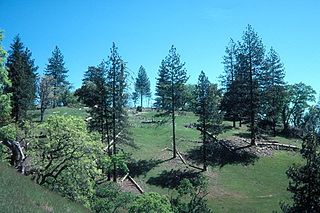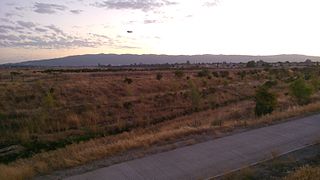Related Research Articles

Henry W. Coe State Park is a state park of California, United States, preserving a vast tract of the Diablo Range. The park is located closest to the city of Morgan Hill, and is located in both Santa Clara and Stanislaus counties. The park contains over 87,000 acres (35,000 ha), making it the largest state park in northern California, and the second-largest in the state. Managed within its boundaries is a designated wilderness area of about 22,000 acres (8,900 ha). This is officially known as the Henry W. Coe State Wilderness, but locally as the Orestimba Wilderness. The 89,164-acre (36,083 ha) park was established in 1959.
The community of San Antonio Valley, also called San Antonio or San Antone, is located along the Diablo Range in eastern Santa Clara County, California. The locale is bordered by Alameda County to the north and Stanislaus County to the east. The sparsely populated area is located at the junction of San Antonio Valley Road, Mines Road, and Del Puerto Canyon Road. The area includes the San Antonio Valley Ecological Reserve, a 3,282 acre nature preserve created by a Nature Conservancy purchase of land from local rancher, Keith Hurner, and known for its herd of tule elk.

Arroyo Mocho is a 34.7-mile-long (55.8 km) stream which originates in the far northeastern corner of Santa Clara County and flows northwesterly into eastern Alameda County, California. After traversing the cities of Livermore and Pleasanton it joins South San Ramon Creek to become Arroyo de la Laguna, which in turn flows to Alameda Creek and thence to San Francisco Bay.
Point of Timber is a former settlement in Contra Costa County, California. It was located on Indian Slough 2 miles (3.2 km) north of Byron, and about 2.5 miles east of Union Cemetery in Brentwood. It was originally named Point of Timber Landing. The landing was built by Josiah Wills, who organized the deepening of Indian Slough, connecting the landing to the Old River. Point of Timber got its name from the mile wide strip of open Oak woodland that ran from just east of the house of John Marsh along the course of Arroyo del Sur to the edge of the marshes bordering Indian Slough and Old River.
Poso de Chane or Poso Chane is a former settlement in Fresno County, California situated around the waterhole of that name, northwest just below the confluence of the Jacalitos Creek with Los Gatos Creek, 6 miles (9.7 km) east of Coalinga and northwest of the Guijarral Hills.
La Vereda del Monte was a backcountry route through remote regions of the Diablo Range, one of the California Coast Ranges. La Vereda del Monte was the upper part of La Vereda Caballo,, used by mesteñeros from the early 1840s to drive Alta California horses to Sonora for sale.
Murrieta Rocks originally named Las Tinajas,, refers to the waterholes to be found eroded into the Vaqueros Sandstone on top of the outcrop. The location is at a large outcrop of Vaqueros Sandstone, called Murrieta Rocks, about a mile northeast of Brushy Peak just within the southern bounds of the Rancho Cañada de los Vaqueros in California. From the east, the outcrop overlooks a spring in an eastern tributary arroyo to the upper Kellogg Creek that flows down from Brushy Peak.
Blackbird Valley, earlier known as "Valle de Mocho", is a valley south of Mount Mocho in the Diablo Range in Santa Clara County, California. It lies at an elevation of 2,552 foot / 778 meters.
Isabel Valley is a valley in the Diablo Range in Santa Clara County, California. It is also known as Santa Ysabel Valley.
Mississippi Creek is a tributary stream to Pacheco Creek in Santa Clara County, California.
Valle Atravesado,, a small, east-west running valley that crosses the north-south running valley of the upper reach of Mississippi Creek in the Diablo Range, in Santa Clara County, California.
French Ranch is a locale northeast of Hollister in the Diablo Range, in San Benito County, California. It lies on a flat just south of Wildcat Canyon at an elevation of 1,821 feet at the foot of Frenchs Pass. It lies west of an unnamed stream that descends northward to its confluence with Wildcat Canyon Creek from the north slope of Antimony Peak.
Frenchs Flat is a flat along the divide of the Diablo Range south of Pacheco Pass in Santa Clara County, California. It lies at an elevation of 1,362 feet south southwest of Pacheco Pass.
Mustang Peak is a mountain summit along the divide of the Diablo Range in Stanislaus County, California. It rises to an elevation of 2,251 / 686 meters.
Paradise Flat is a flat in the Diablo Range, within Henry W. Coe State Park in Stanislaus County, California. It lies at an elevation of 1,224 / 373 meters along north bank of the South Fork Orestimba Creek, just above the Rooster Comb.
Mustang Flat is a flat in the Diablo Range in Stanislaus County, California. It lies at an elevation of 1,329 feet south of the South Fork Orestimba Creek, north of Mustang Peak.
Fifield Ranch is a locale within the Diablo Range in Santa Clara County, California. It lies at an elevation of 1,512 feet, west of the head of Romero Creek and the Santa Clara County line, about a mile north of Hagerman Peak. It is at the source of a tributary canyon and stream to Chimney Gulch, itself a tributary of East Fork Pacheco Creek.
County Line Road is an unimproved road between the San Antonio Valley and Fifield Ranch that closely follows the east-west divide of the Diablo Range and the County boundary of Santa Clara County, and Stanislaus County, California. This road followed the route called La Vereda del Monte, used by Californio mesteñeros and the gang of Joaquin Murrieta and other bandits and horse-thieves, and sites of three of their camps along the route are found along it. Two sites are now state park campgrounds, the last is at ranch dating back to the 1860s.
Bullhead Canyon, is a canyon and tributary stream of the North Fork Pacheco Creek in Santa Clara County, California. Its mouth is on its confluence with North Fork Pacheco Creek at an elevation of 630 feet / 192 meters. Its source and its upper reach is at 37°10′08″N121°19′04″W within the boundary of Henry W. Coe State Park. It is overlooked to the north by the County Line Road,, that runs west to east along the divide of the Diablo Range and the boundary of Santa Clara and Stanislaus County, California.
Corral Redondo was a historical locale in San Benito County, California. It was located a little over two miles above the mouth of the Arroyo de Corral on the Arroyo Panoche Grande at the eastern foot of the trail over Panoche Pass to the west. The site of Corral Redondo is a natural, high banked, almost round loop in the channel of Griswold Creek that mesteñeros turned into a corral by enclosing its open ends with drag lines, poles and brush.
References
- ↑ Frank F. Latta, JOAQUIN MURRIETA AND HIS HORSE GANGS, Bear State Books, Santa Cruz, California. 1980.